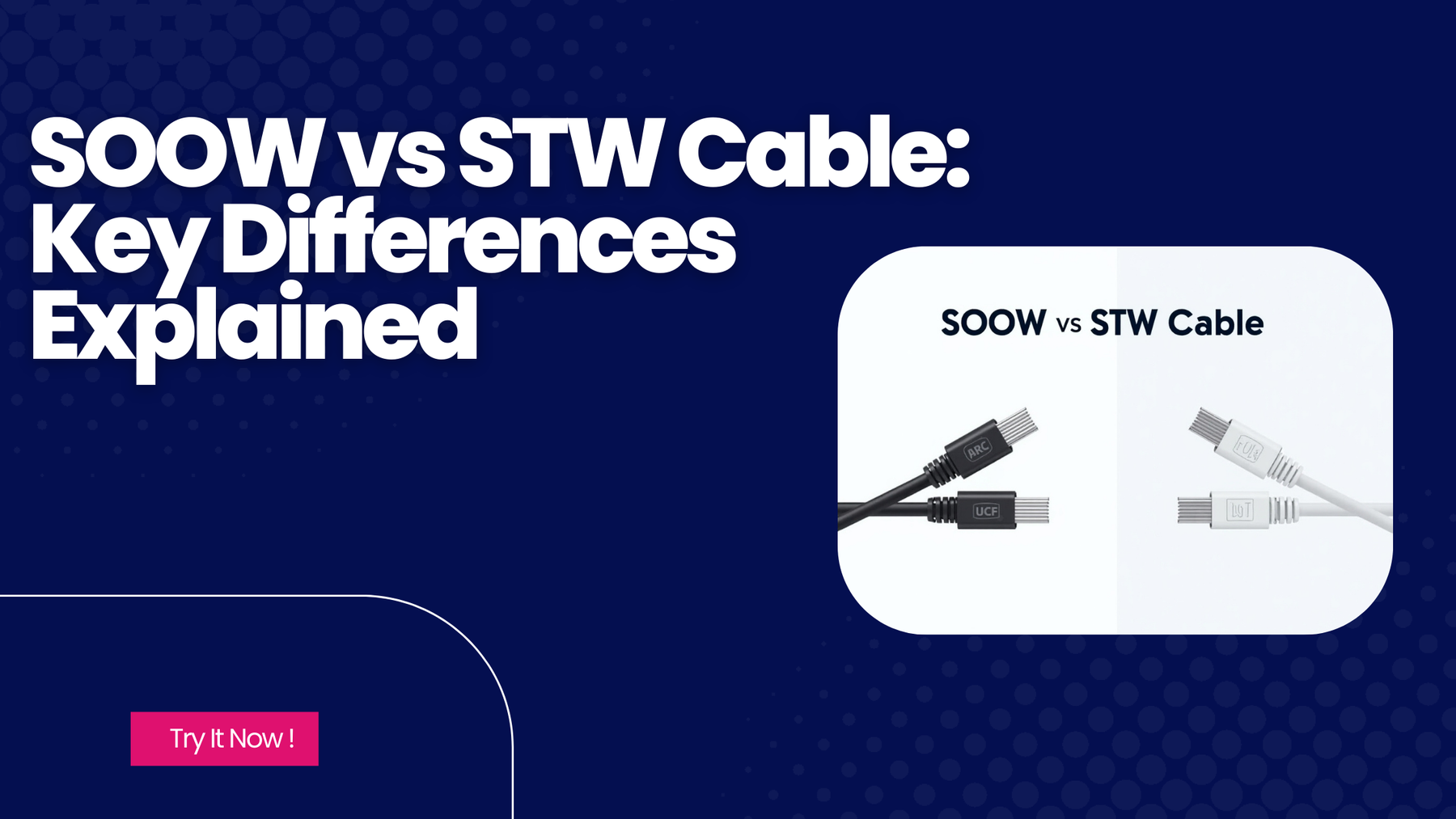
SOOW vs STW Cable: Key Differences Explained
When choosing the right portable power cord, two names come up often: SOOW and STW. Both are rated for 600 volts and built for outdoor use, but their construction and flexibility make them better suited for different jobs. Let’s break down their differences in a clear, practical way.
What Are SOOW and STW Cables?
The main difference between SOOW and STW cable lies in the materials and flexibility.
SOOW cable is a heavy-duty service cord made with a thermoset rubber insulation and jacket. It’s oil-resistant, weather-resistant, and rated for 600 volts. Its rubber build allows it to stay flexible in tough conditions, making it ideal for industrial machinery, construction sites, stage lighting, or any environment that demands frequent movement and durability.
STW cable, on the other hand, uses thermoplastic PVC insulation and jacket. It’s also weather-resistant and rated for 600 volts, but is less flexible than SOOW. PVC jackets tend to stiffen in cold conditions, which makes STW cords more suited for general outdoor or residential applications where cables don’t move as much.
In short: SOOW offers rugged flexibility for industrial demands, while STW provides a cost-effective, reliable option for light- to medium-duty outdoor use.
Breakdown of Cable Letter Codes (SOOW vs STW)
Every letter in a cable designation has meaning, and understanding them makes it easier to select the right cord.
SOOW cable letters:
-
S = Service cord (flexible portable cable).
-
O = Oil-resistant insulation.
-
O (second) = Oil-resistant jacket.
-
W = Weather- and water-resistant.
Together, SOOW stands for Service cord, Oil-resistant insulation, Oil-resistant jacket, Weather-resistant. It’s a flexible, rubber-sheathed cable designed to survive in oil-rich, wet, or outdoor environments.
STW cable letters:
-
S = Service cord.
-
T = Thermoplastic insulation and jacket.
-
W = Weather- and water-resistant.
STW cords use PVC thermoplastic jackets. They’re durable and suitable for outdoor use, but they don’t handle oil, chemicals, or extreme cold as well as SOOW.
The difference in letter coding reveals the core distinction: SOOW is rubber-based (thermoset), while STW is plastic-based (thermoplastic). SOOW excels in flexibility and resistance, whereas STW prioritizes affordability and general weather durability.
Material & Construction Differences
The choice between SOOW and STW cables largely comes down to what they’re made of.
SOOW construction:
-
Thermoset rubber insulation and jacket.
-
Remains flexible in freezing conditions.
-
Resists cracking, abrasion, oils, and chemicals.
-
Withstands frequent bending and movement.
This makes SOOW cords ideal for heavy-duty industrial and commercial use where reliability is essential.
STW construction:
-
Thermoplastic PVC insulation and jacket.
-
Tough and weather-resistant, but stiffens in cold.
-
Not oil- or abrasion-resistant.
-
Performs best in applications with minimal movement.
Because rubber is more costly than PVC, SOOW cords generally have a higher upfront price. However, they last longer, resist harsh environments, and deliver more value in the long run. STW cords are more affordable and perform well for light-duty outdoor applications.
In summary: SOOW = rubber flexibility + durability. STW = PVC strength + affordability. Your choice should reflect the working environment and required durability.
Voltage, Temperature, and Durability Comparison
Both SOOW and STW are rated at 600 volts, so voltage is not the deciding factor. Instead, performance differences emerge in temperature tolerance and durability.
SOOW cable ratings:
-
Temperature range: -40°C to 90°C.
-
Flexible in extreme cold and heat.
-
Oil-resistant jacket protects against chemicals and abrasion.
-
Built for constant handling, pulling, or coiling.
STW cable ratings:
-
Temperature range: -20°C to 60°C.
-
Sufficient for most outdoor environments, but stiffens in freezing weather.
-
Not designed for industrial oil or heavy chemical exposure.
-
Performs well in semi-fixed or occasional-use setups.
Durability is the deciding factor. SOOW can handle tough industrial conditions, while STW is intended for consumer-level, lighter outdoor use. If your application involves heavy movement or exposure to oils and chemicals, SOOW is the better choice. For seasonal extension cords or household equipment, STW is more than sufficient.
Ideal Applications for SOOW vs STW
The right cable depends on where and how it will be used.
SOOW cable applications:
-
Construction sites and factories.
-
Portable tools and heavy machinery.
-
Welding machines and compressors.
-
Stage lighting and sound equipment.
-
Temporary power distribution.
STW cable applications:
-
Outdoor extension cords.
-
Generators and small appliances.
-
Lawn and garden tools.
-
Seasonal outdoor decorations.
In short, SOOW is designed for heavy-duty industrial use, while STW is best for everyday outdoor or residential needs.
Pros & Cons of Each Cable Type
SOOW Cable Pros:
-
Extremely flexible, even in freezing weather.
-
Resistant to oils, chemicals, and abrasion.
-
Long service life in demanding environments.
SOOW Cons:
-
More expensive.
-
Heavier and thicker to handle.
STW Cable Pros:
-
Cost-effective and widely available.
-
Durable enough for outdoor consumer use.
-
Weather-resistant and 600V rated.
STW Cons:
-
Less flexible, especially in cold weather.
-
Not oil- or abrasion-resistant.
How to Choose the Right Cord for Your Project
The best way to choose between SOOW and STW is to consider your environment.
-
If your project involves industrial machinery, frequent movement, oil, or chemical exposure, SOOW cables are worth the investment. Their rubber jacket ensures flexibility, safety, and durability under stress.
-
If your application is lighter, like seasonal outdoor lighting, small generators, or portable household equipment, STW provides reliable performance at a lower cost.
Rule of thumb:
-
Heavy-duty, industrial = SOOW.
-
Residential, occasional outdoor = STW.
Conclusion
When comparing SOOW vs STW cables, the key difference lies in construction and performance. SOOW’s rubber build makes it the superior choice for industrial, high-movement, and extreme environments. STW’s PVC construction offers a more affordable, durable solution for everyday outdoor power needs.
At Global Cable Wire, we stock both SOOW and STW cables to match your exact project requirements. Whether you require heavy-duty flexibility or cost-effective reliability, our team can help you select the ideal cable for the job.
Contact Global Cable Wire today to get expert guidance and high-quality cables at the right price.
FAQs (Frequently Asked Questions)
Q: What does SOOW stand for?
A: Service, Oil-resistant insulation, Oil-resistant jacket, Weather-resistant. It’s a flexible, rubber-jacketed portable power cable.
Q: What does STW stand for?
A: Service, Thermoplastic jacket, Weather-resistant. A PVC-based outdoor power cord.
Q: Can we use STW cable indoors?
A: Yes, but it’s most commonly used outdoors because of its weather-resistant PVC jacket.
Q: Which cable is more flexible?
A: SOOW. Its rubber construction stays flexible in a wide temperature range.
Q: Is SOOW suitable for extreme cold?
A: Yes. SOOW remains flexible down to -40°C, making it safe for harsh winter use.
Q: Which is more affordable?
A: STW is usually cheaper because PVC costs less than rubber.
Q: Which lasts longer?
A: SOOW typically lasts longer in harsh environments due to its rugged build.
